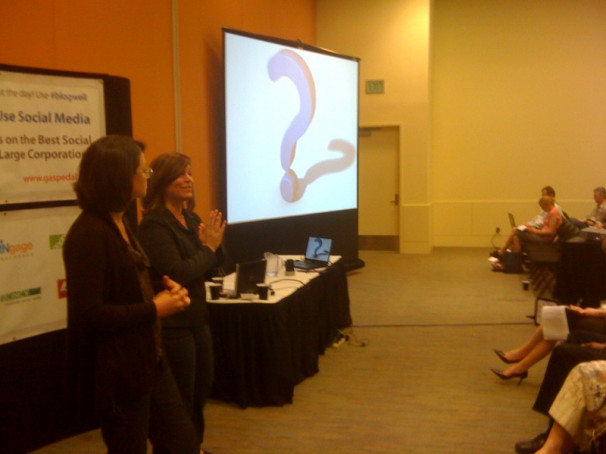3:50 — Kurt Vanderah introduces Duke Engery’s Social Media Specialist, Lisa Hoffmann, and Michelle Pearson, Director of Social Media.
3:50 – Michelle takes us on a journey of how first got started – with genuine need. On the eve of a winter storm approaching Cincinnati area. Went into normal practice to start preparing to alert the public. Knew from previous storms that customers wanted more opportunities to engage through mobile messaging. Started with Twitter pilot, inspired by great work of Red Cross.
3:53 – Michelle says idea was simple: Proposed to share bits and pieces. Links to outage maps, how to report an outage… Successfully used in the first storm and another of others. Took baby steps – used during storms.
3:54 – Lisa explains how they groomed the channel. Joined company in the fall when Twitter first started. Hired because know social media. Tell executives that build awareness. Look for opportunities to talk to them, reach out and have a conversation. Be open to criticism. Gets scary at times.
3:56 – Lisa says criticism is an opportunity. Each time address a situation with openness, graciousness and neutrality.
3:57 – Lisa says pictures speak volumes in an industry where people don’t always trust you. Showed photo of staff ready to serve them over night if their power went out. Also posted a video on YouTube – how to report an outage. People liked seeing call center action in background.
3:58 – Lisa explains how to gain continued support. Internal stakeholders care about follower counts. Want to see that people are sharing, retweeting. Instant feedback. Show that people are responding well; are generating good will.
4:00 – Lisa makes sure to share positive comments with guys in the field, that they are appreciated.
4:00 – Lisa tries to keep it relative. Rain forecast, and here’s what you can do with your kids.
4:02 – Lisa uses a sense of humor in her tweets. Be yourself. Be authentic.
4:02 – Lisa says time management is a big thing when managing three Twitter accounts for a company. Has created work flow guides for each account – a daily schedule with tasks such as checking in the afternoon for retweets and thanking people for them.
4:03 – Lisa makes a schedule, and tries to do the most important work first. Do Twitter before e-mail.
4:04 – Lisa sets a timer. Likes to help customers and change their opinion of the company. People like you trying to get the job done. But… get carried away with it, so need to set a timer.
4:05 – Lisa says real-time response was the biggest challenge she saw – especially when a lot of people have their power out.
4:06 – Lisa says Duke applies crisis response model to social media. Retweets and replies.
4:08 – Lisa says it take an “all hands on deck” commitment to social media crisis situations. Example: Customer service manager on hand all day. Get key resources in the room or at the ready.
4:09 – Lisa says regular reporting is important. What’s happening now?
Q&A
Q: How does legal factor into this?
A: Consider this just another channel, such as standing in front of a television channel. Already vetted by people who understand rules and regulations.
Q: Any strategy for attracting Twitter followers?
A: Have a social media page on Web site. Newsletter. Include in news releases. Connect with weather reporters.
Q: Will you expand beyond Twiter?
A: We are involved with digitizing the grid, a social newsroom – WordPress blog. Have two other Twitter handles also, including one about energy efficiency.
Q: How do you capture the important tweets and route to appropriate people?
A: Something we do. We sit within Corporate Communications function.
Q: Using any tools to help you listen?
A: Radian6 dashboard used on daily.
Q: Outage map feedback?
A: Pay attention to which links get the most clicks and RT’s. Those get the most. Have been around long time.
Q: Regarding the schedule and going back at 3 p.m. every day. Is it better to go back variety of times?
A: Don’t always follow the schedule. It’s a way to make sure that I get there. Good point: Need to vary the times. I don’t tweet on weekends unless there’s a storm. I monitor all of the time, though, even on weekends.
Q: Examples of how to deal with irate customer who keeps tweeting, even though you try to help off-line.
A: There are some people you’re never going to turn around. Most are happy to get a response.
Q: How do you decide who gets to send out tweets?
A: Right now, the two of us. Goal to find enthusiasts and subject matter experts.
3:50 – Michelle takes us on a journey of how first got started – with genuine need. On eve of winter storm approaching Cincinnati area. Went into normal practice to start preparing to alert the public. Knew from previous storms that customers wanted more opportunities to engage through mobile messaging. Started with Twitter pilot, inspired by great work of Red Cross.
3:53 – Michelle says idea was simple: Proposed to share bits and pieces. Links to outage maps, how to report an outage… Successfully used in the first storm and another of others. Took baby steps – used during storms.
3:54 – Lisa tells how groomed the channel. Joined company in the fall when Twitter first started. Hired because know social media. Tell execs that build awareness. Look for opportunities to talk to them, reach out and have a conversation. Be open to criticism. Gets scary at times.
3:56 – Lisa says criticism is an opportunity. Each time address a situation with openness, graciousness and neutrality…
3:57 – Lisa says pictures speak volumes in an industry where people don’t always trust you. Showed photo of staff ready to serve them over night if their power went out. Also posted a video on YouTube – how to report an outage. People liked seeing call center action in background.
3:58 – Lisa explains how to gain continued support. Internal stakeholders care about follower counts. Want to see that people are sharing, retweeting. Instant feedback. Show that people are responding well; are generating good will.
4 – Lisa makes sure to share positive comments with guys in the field, that they are appreciated.
4 – Lisa tries to keep it relative. Rain forecast, and here’s what you can do with your kids.
4:02 – Lisa uses a sense of humor in her tweets. Be yourself. Be authentic.
4:02 – Lisa says time management is a big thing when managing three Twitter accounts for a company. Has created work flow guides for each account – a daily schedule with tasks such as checking in the afternoon for retweets and thanking people for them.
4:03 – Lisa makes a schedule, and tries to do the most important work first. Do Twitter before e-mail.
4:04 – Lisa sets a timer. Likes to help customers and change their opinion of the company. People like you trying to get the job done. But… get carried away with it, so need to set a timer.
4:05 – Lisa says real-time response was the biggest challenge she saw – especially when a lot of people have their power out.
4:06 – Lisa says Duke applies crisis response model to social media. Retweets and replies.
4:08 – Lisa says it take an “all hands on deck” commitment to social media crisis situations. Example: Customer service manager on hand all day. Get key resources in the room or at the ready.
4:09 – Lisa says regular reporting is important. What’s happening now?
Questions and Answers
Q: How does legal factor into this?
A: Consider this just another channel, such as standing in front of a television channel. Already vetted by people who understand rules and regulations.
Q: Any strategy for attracting Twitter followers?
A: Have a social media page on Web site. Newsletter. Include in news releases. Connect with weather reporters.
Q: Will you expand beyond Twiter?
A: Are involved with digitizing the grid, a social newsroom – WordPress blog. Have two other Twitter handles also, including one about energy efficiency.
Q: How do you capture the important tweets and route to appropriate people?
A: Something we do. We sit within Corporate Communications function.
Q: Using any tools to help you listen?
A: Radian6 dashboard used on daily.
Q: Outage map feedback?
A: Pay attention to which links get the most clicks and RT’s. Those get the most. Have been around long time.
Q: Schedule. Going back at 3 p.m. every day. Better to go back variety of times.?
A: Don’t always follow the schedule. Is a way to make sure that get there. Good point: Need to vary the times. Don’t tweet on weekends unless storm. Are monitoring all of the time, though, even on weekends.
Q: Examples of how deal with irate customer who keeps tweeting, even though try to help off-line.
A: Are some people you’re never going to turn around. Most are happy to get a response.
Q: How do you decide who gets to send out tweets?
A: Right now, the two of us. Goal to find enthusiasts and subject matter experts.




